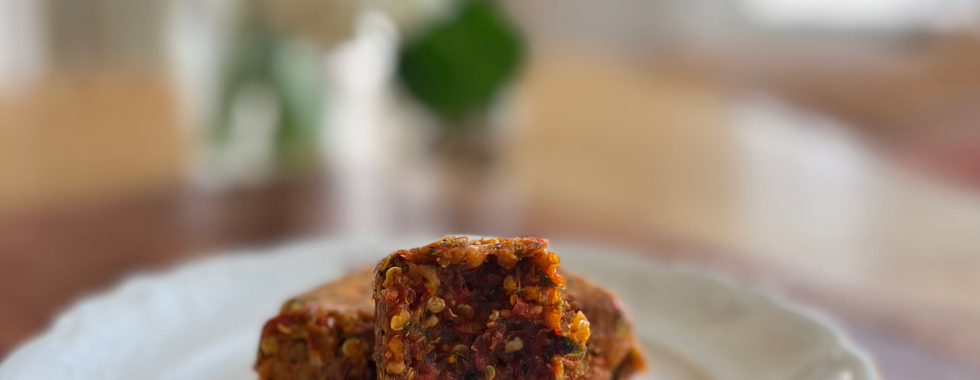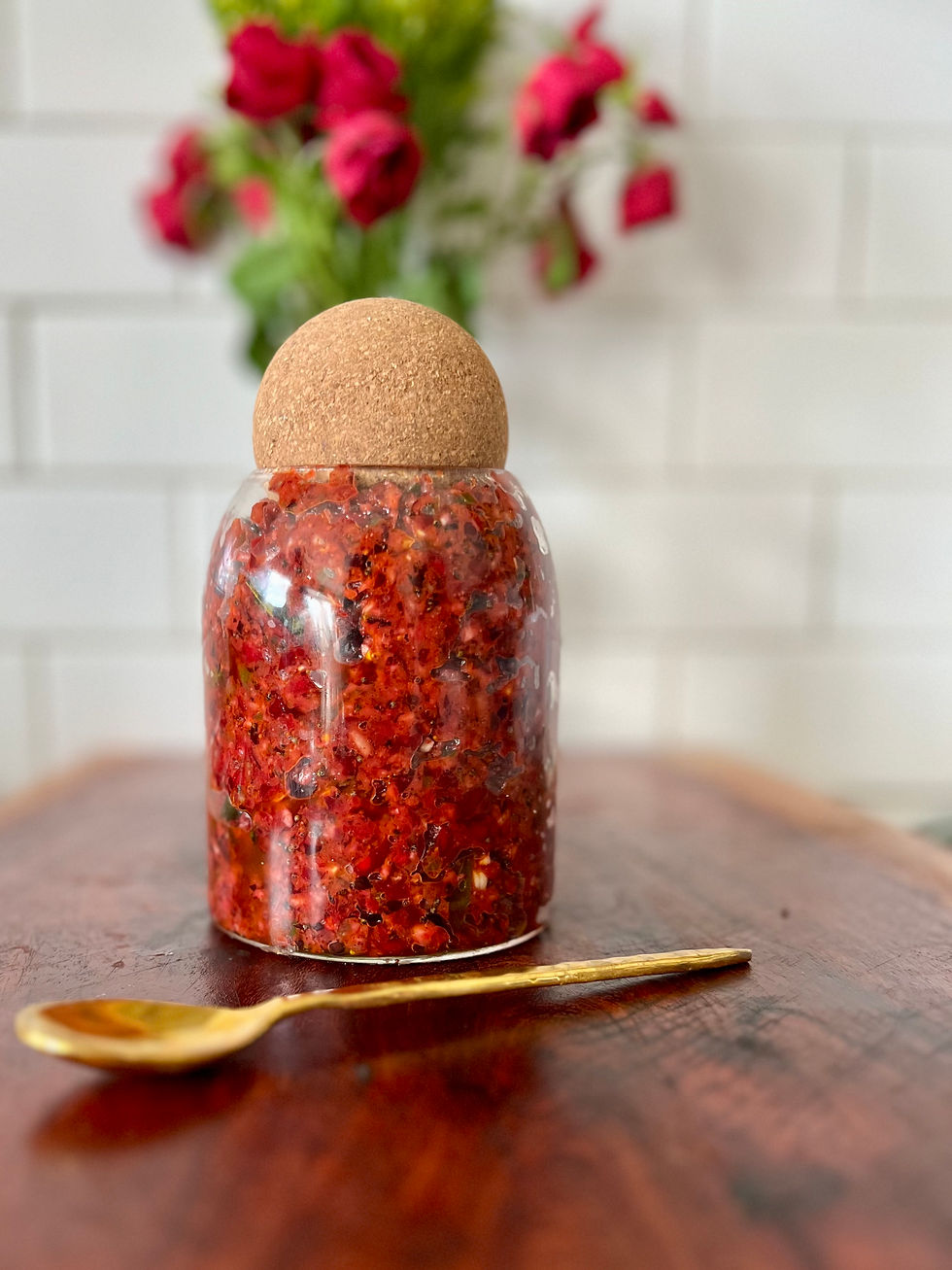Freezing homemade pastes
- Savitha Enner

- Jul 27
- 6 min read
Updated: Aug 18
Traditional Taste, Practical Timeline—Because Wisdom Evolves
I know there's much stigma attached to meal prep and frozen foods. Personally, I don't freeze much. My lifestyle allows me to cook fresh food every day, multiple times a day. I even grow most of our vegetables throughout the garden season.
However, I hold no judgment toward smart home cooks who plan, prep, and freeze. They do this to manage a full-time job, pursue bigger ambitions, or simply choose to be more involved in their kids' lives or serve their community. Just yesterday, I shared some refrigeration ideas with my mother-in-law to make her life easier. I often discuss smart cooking with my sister and friends. We focus on saving time without compromising flavor and nutrition.
The Importance of Health
Is your health the most important wealth to treasure? Of course! But that doesn't mean you should feel guilty about serving leftovers.
If you're a young mother, you probably need sleep, not guilt for not growing your own strawberries for smoothies that your child may not even finish. If you're an immigrant student, you need to focus on finding a project, landing a job, and making friends to laugh with. If you're a middle-aged woman, you likely need to exercise and build strength to age gracefully.
But if you've chosen to make fresh meals every day (like me), let's celebrate that too. Maybe you can make a bit extra and share with your busy neighbor.
What I Freeze
Here are a few things I freeze:
Homemade Pesto: We grow an insane amount of basil in summer. Even my frozen recipe tastes much better than store-bought ones.
Tamarind Pulp Frozen into Cubes: Check my method below.
Roasted Chili and Garlic: Perfect for adding spice to plain dal in a hurry.
Mint and Cilantro Chutney: I’m the only one who likes it in my family, so I freeze a small batch for when the craving hits.
Oven-Roasted Tomatoes: Pureed and frozen in large blocks as our garden tomatoes are incredibly flavorful.
My Recipes
Pistachio Pesto
Because sometimes basil needs a luxurious upgrade
What You Need:
2 cups fresh basil leaves (packed)
½ cup shelled pistachios (unsalted)
3-4 garlic cloves
½ cup good olive oil
½ cup freshly grated Parmesan
Salt and black pepper to taste
Squeeze of lemon juice (optional, but brightens everything)
How to Make It:
Toast the pistachios lightly in a dry pan for 2-3 minutes until fragrant. Let them cool completely.
Toss everything except the oil into your food processor. Pulse a few times, then slowly drizzle in the olive oil while running until you get your desired consistency—chunky or smooth, your call.
Taste and adjust.
Pro Tips:
This keeps in the fridge for a week with a thin layer of olive oil on top.
Freezes beautifully in ice cube trays for quick weeknight pasta wins.
Try it on grilled vegetables, spread on crusty bread, or stirred into risotto.
For an Indian twist, add a touch of chat masala and toss it with cucumbers for a refreshing salad.
The pistachios add this gorgeous green color and rich, buttery flavor.
Pressure Cooker Tamarind Pulp for Freezing
Make this once, use it for months
What You Need:
500g tamarind (available in blocks at the Indian store)
Pinch of salt (optional, helps preserve)
Pressure Cook:
Add tamarind and water to your pressure cooker. The water should just cover the tamarind.
Pressure cook for 2-3 whistles (about 8-10 minutes on high pressure). Let it naturally release pressure.
Once cooled slightly, use your immersion blender directly in the pot. Blend until the mixture becomes a thick, smooth paste.
Pour the blended mixture through a mesh strainer. Use the back of a spoon to push the pulp through, leaving behind seeds and fiber. For extra smooth pulp, strain twice. The extra left in the strainer can be mixed with more water, strained again, and bottled up for immediate use.
Freeze Smart:
Pour into ice cube trays for portion control, or freeze in small containers. Each cube is roughly 1-2 tablespoons—perfect for curries and chutneys.
Pro Tips:
The pulp keeps frozen for 6 months.
Add that pinch of salt to extend freezer life.
This method gives you the perfect balance of convenience and authentic flavor. I thaw a few in the refrigerator for everyday use. This seems like a lot of work but saves time in the long run. I do not like the tamarind paste available in jars, so I go the extra mile.
Oven-Roasted Chili Garlic Paste
I am using ripened red chili for this, but green ones work great too
What You Need:
40 to 50 dried red chilies
2 whole garlic bulbs (about 10-12 cloves)
2-3 tablespoons oil
Pinch of salt
The Method:
Prep for Roasting: Preheat oven to 400°F (200°C). Remove stems from chilies—seeds can stay for heat or be removed for a milder flavor. Break garlic bulbs into individual cloves but keep skins on. Toss chilies and unpeeled garlic cloves with a drizzle of oil on a baking sheet. Spread in a single layer.
Roast for 12-15 minutes until chilies are fragrant and slightly darkened, and garlic skins are golden. Let everything cool completely. The garlic skins should slip off easily now—that roasting makes them sweet and mellow.
Pulse chilies and peeled garlic in a food processor with remaining oil and salt. You want a coarse, chunky paste—not smooth. Think rustic texture with visible chili flakes.
Store Smart:
Keep in the fridge for 2 weeks or freeze in small portions. A tablespoon goes a long way.
How to Use:
Add 1-2 tablespoons to hot oil at the start of any curry.
Stir into dal for instant depth.
Mix with yogurt for a quick marinade.
Toss with roasted vegetables.
The oven does all the work here—no standing over the stove, no burning. Just pure, concentrated flavor that makes everything taste like it simmered for hours.
Oven-Roasted Summer Tomato Puree for Freezing
Capture peak summer in jars—your winter curries will thank you
What You Need:
3-4 lbs ripe summer tomatoes (any variety, imperfect ones work perfectly)
3-4 tablespoons olive oil
1 teaspoon salt
1/2 teaspoon black pepper
4-5 garlic cloves, smashed (optional)
Fresh herbs like thyme or basil (optional; I skip this for Indian prep)
The Method:
Preheat oven to 425°F (220°C). Core tomatoes and cut larger ones in half, leaving cherry tomatoes whole. No need to peel—the skins will blend beautifully after roasting.
Toss tomatoes with oil, salt, pepper, and garlic on large rimmed baking sheets. Don't overcrowd—use two sheets if needed. Roast for 45-60 minutes until edges are caramelized and tomatoes are deeply golden and concentrated.
Let cool completely. The tomatoes will have released their juices and concentrated their flavors beautifully. Blend everything (including all those caramelized bits) with an immersion blender right on the sheet, or transfer to a regular blender.
For silky smooth puree, pass through a fine mesh strainer. For rustic texture, leave as is—I prefer the latter for most curries. Cool completely before freezing. Pour into ice cube trays for portion control, or freeze flat in freezer bags. Each cube equals about 2 tablespoons.
Storage:
Refrigerate up to 1 week.
Freeze up to 8 months.
No need to thaw—add frozen cubes directly to a hot pan.
Perfect For:
Base for any tomato curry.
Quick pasta sauces.
Soup starter.
Pizza sauce with added herbs.
Sambar or rasam.
Tomato chutney.
This is summer sunshine preserved. The roasting concentrates all that sweet, acidic perfection into liquid gold that makes store-bought puree taste like water.
Mint Cilantro Chutney with Ginger & Lime
The bright, zippy condiment that makes everything taste alive
What You Need:
1 cup fresh mint leaves (packed)
1 cup fresh cilantro leaves and tender stems (packed)
1-inch piece fresh ginger, peeled
2-3 green chilies (adjust to taste)
Juice of 1 large lime
1/2 teaspoon salt
1 teaspoon sugar (optional, balances the tang)
2-3 tablespoons water
The Method:
Clean and Prep: Wash mint and cilantro thoroughly, spin dry. Don't obsess over perfect leaves—tender stems add great flavor too. Roughly chop the herbs, ginger, and chilies. This helps your blender or food processor work more efficiently.
Add everything to your blender or food processor. Start with less water, pulse a few times, then blend until you get a coarse-smooth consistency. Add water gradually—you want it thick enough to coat a spoon but not chunky. Adjust the taste with more lime for tang, more salt for brightness, or another chili for heat.
Storage Tips:
Keeps in the fridge for 4-5 days with an oil layer on top.
Freeze in ice cube trays for up to 3 months.
Add a splash of oil on top before storing to maintain color.
Perfect With:
Pakoras and samosas.
Grilled vegetables.
Spread on sandwiches or wraps.
Stirred into yogurt for quick raita.
Dolloped on any curry that needs brightness.
Unfortunately, no one in my family likes this chutney as much as I do. So I make a small batch, as this is quick to make if I need a big batch for the family or a party.
Namaste,
Savitha














Comments